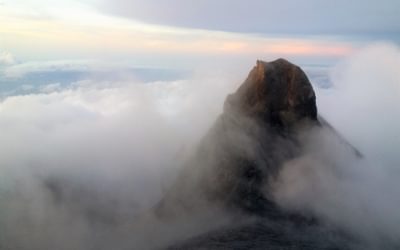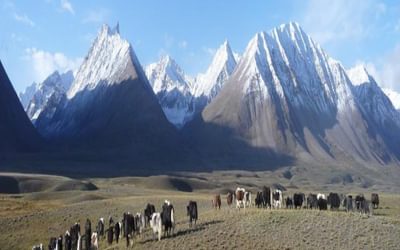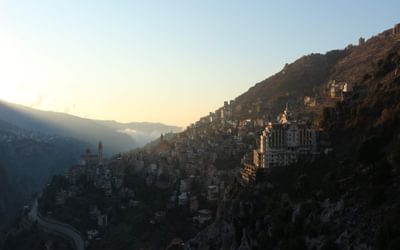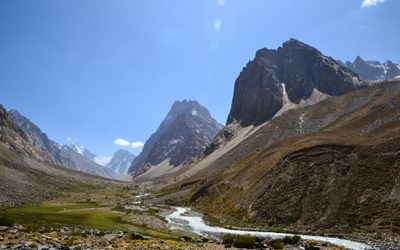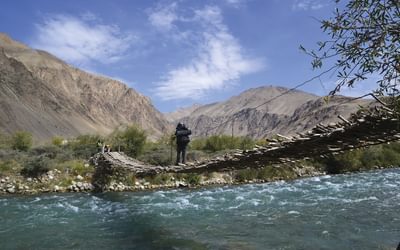Trekking on horseback – Kyrgyzstan's Tien Shan
An account of a two-week trekking expedition on horseback through Kyrgyzstan's Tian Shan, with Wild Frontiers.
There were two questions that typically followed my announcement that I’d be spending a few weeks horse trekking in Kyrgyzstan; ‘where’s that?’ and ‘are you mad?’.
You either know or don’t know the first. If you were to go to the far west of China, or travel south from Russia through Kazakhstan, or north through India, Pakistan and Tajikistan, there you would find Kyrgyzstan. Ninety per cent of the country is over 1500m, so it’s not for nothing that the country is becoming known as the ‘Switzerland of Central Asia’.
As for the second point, I’d only decided to go with a Wild Frontiers expedition two weeks prior to leaving (Kyrgyzstan doesn’t require a visa, so last-minute trips are possible), and I hadn’t regularly ridden a horse in over eight years. So jetting off to have an adventure with people I’d never met, in a country where I knew neither of the two spoken languages, and depending on somewhat rusty skills to travel was maybe a little more adventure than some people are comfortable with.
The trip started in Bishkek, where we’d staggered out of a plane at an unreasonable hour of the morning. We met our horses and began the trek a couple of days later on the shores of Son Kul, a stunning high-altitude lake in the middle of the country. From there, we would be riding south for several days to reach Tash Rabat, and then further to Chatyr Kul – another lake close to the Chinese border – before curving north again.
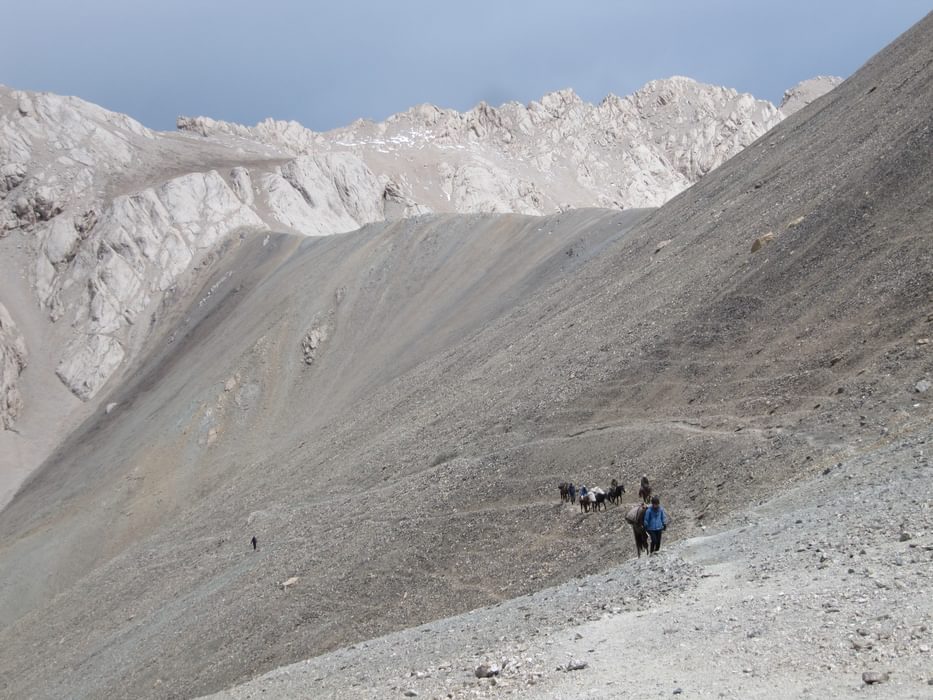
The people
The Kyrgyz people are generous and hospitable to a fault. Who else would welcome six soaked and shivering riders into their yurt, there to huddle like penguins around the heat of the stove, watching steam rise out of jodhpurs and gently cooking waterlogged gloves. And after all that, sit us down and ply us with fresh bread and all the tea we could drink.
Another time, the local famers and shepherds rode up to visit our campsite. And as is only polite and proper, we opened up the vodka. Marat, our trip leader, was the only translator available, and was working overtime with the conversations. But rounds of toasts and songs and shots transcend language barriers, as does one of our group trading hats with the farmer’s young son, so now the Boston Red Sox are well represented in a small valley in Central Asia.
A couple of notes on being a good guest: never refuse the bread, even if you just have a mouthful. And while you don’t have to have any vodka, if a bottle’s been opened, it needs to be drunk then and there, so try and travel with friends if you’re not that keen!
The mountains
The sheer variety of mountain landscape we rode through was boggling. In many ways, I wasn’t sure of exactly what to expect of the Central Tian Shan, but what I got was an endless array of mountains. One minute we were riding through a grander version of the Yorkshire Dales with grassy hillsides rising and rolling in gentle waves. Turn a corner or over a pass and we were faced with a ravine that could have been dropped straight out of the Alps. Narrow, steep, cliff-sided and full of scree and boulders; it was quite an obstacle on our first riding day and demonstrated more than any assurances or promises exactly what Kyrgyz horses are made of. I learnt very quickly that in that environment, my job was to point downhill and concentrate on staying on and trust my horse to work out the rest. They were bred for the mountains and act like goats – hooves digging in at the toe, hopping off rocks and boulders. If I'd tried to get an average UK pony down that same route, I’d probably still be there.
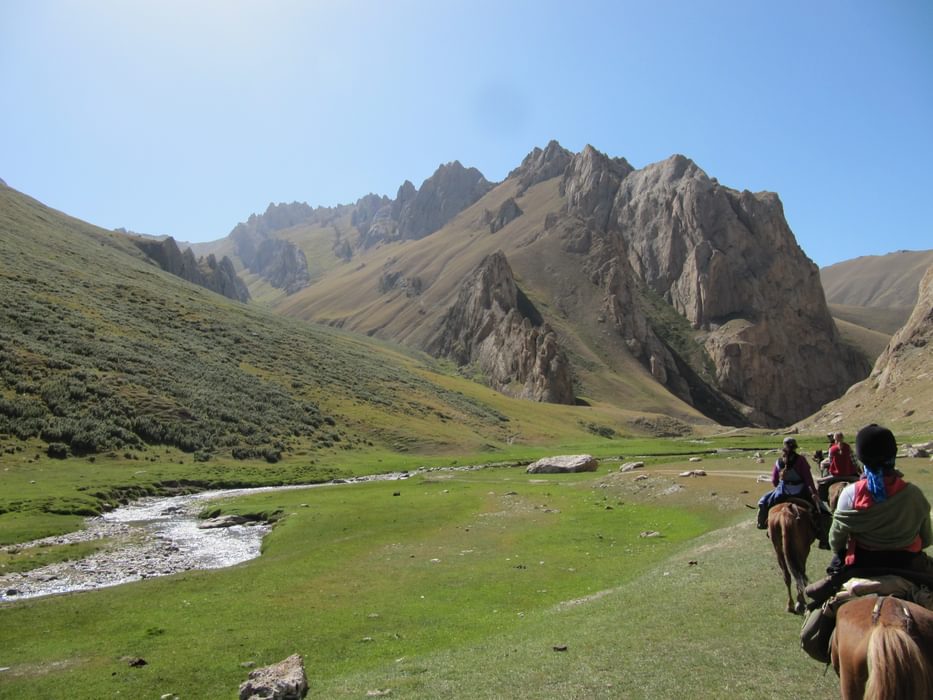
Some mountains and landscapes we rode through surpassed any comparison I could make. Having only spent time walking and trekking in European hills and mountains, the sight of desert hills cut through with alluvial fans and valleys dug out with dry canyons were entirely outside my experience. At one point, as the sun lengthened the shadows and lit up the pale gold desert into hyper-real colour, I thought of a host of leviathans, big as mountains, that had beached on this arid land, whose skin had turned to tawny velvet over the years and now clung to the knuckles of spines and the ridges of ribs. How else could I describe what I was seeing?
We rode past limestone Dolomite-like towers, through blue slate valleys like the Lake District. There were miles of open plains, craggy hills of red ochre earth, snow-capped peaks and long ranks of cliffs twisted and skewed by geology.
No matter what it was that I was expecting before I went, the variety and scope of the Tian Shan mountains were a constant delight. Where else could you travel through mountain architecture so diverse? It honestly seemed to have everything you could imagine and plenty more beyond that.
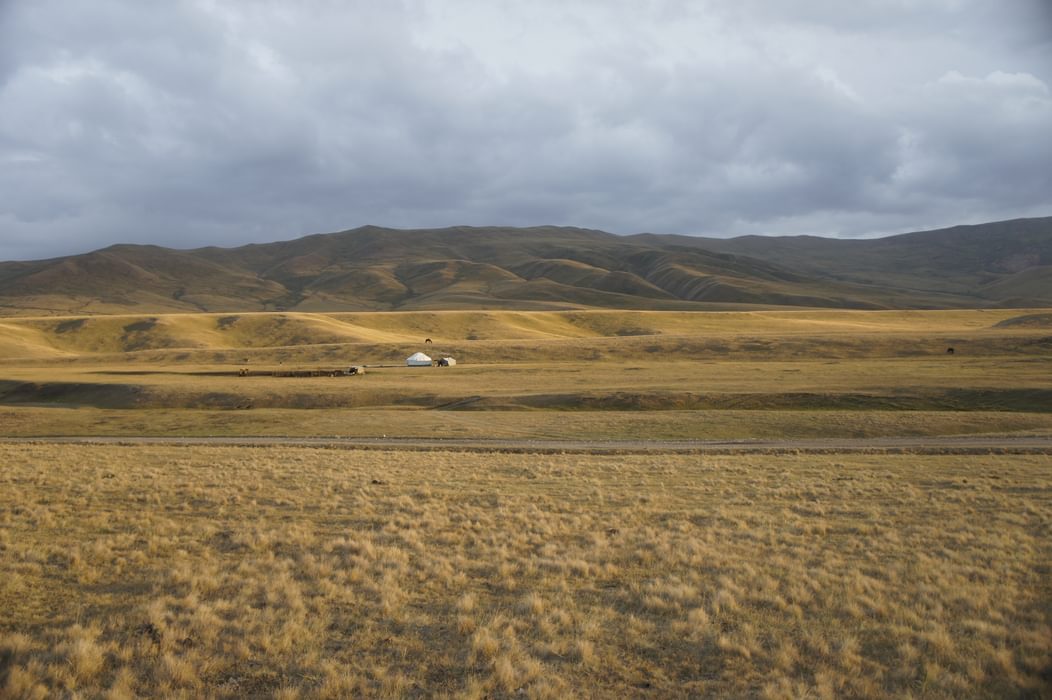
Tash Rabat and the high route to Chatyr-Kul
Tash Rabat is a Silk Road caravanserai close to the Chinese border, thought to have been built in the 15th century, although some believe it is older. In a green valley that winds south, Tash Rabat is built of the same dark, blueish slate as the hills that rise behind it. We wandered its nooks and corridors, beneath the dome of the main hall and pictured traders huddled in small rented rooms, haggling over goods in the long narrow goods stores, watching smoke rise from the ventilation holes that peppered the roof.
Marat told us ancient stories of caravans and travellers, slaves and soldiers and breathed life into a remote, and long-forgotten trading post.
Why long-forgotten? Tash Rabat had been 'rediscovered' and excavated back in the ‘70s, before which shepherds had been making good use of the thick walls to shelter their livestock; filling the rooms and halls with centuries of muck.
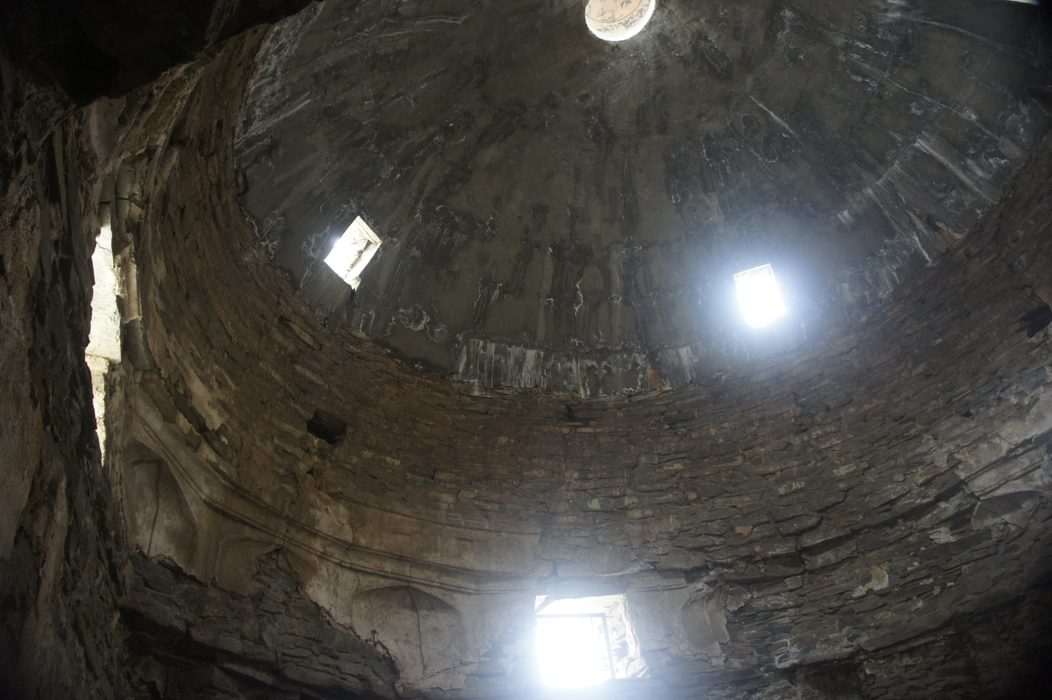
After our rest day – during which we explored Tash Rabat, played cards (multi-national and lingual Thai Poker, quite an experience) and became deliriously happy with the tiny sauna and hot water – we saddled up and set off up the valley towards a forbidding sheer wall of rock and ice, somewhere close to 5000m. Our path flitted over a river and steadily climbed craggy hillsides that began to drop sharply into a river-cut gorge. The horses were raring to go after their lazy day, mine particularly taking it upon himself to canter up foot-wide paths with precipitous drops to the side.
The Kyrgyz only name a few of their horses, so many of the stallions we were riding weren’t named at all (there are so many, it would be like a Lake District farmer naming all his sheep). In a fit of Classical inspiration – what else am I to do with my degree? – I’d named mine Bucephalus, but most of the time he was just Bucky. Our other horses included Dollar (named for a dollar-branding on his hindquarters), Billy the Kick, Luis Suarez (he was a biter), Lada (after the infamous Soviet car; he had a dodgy middle gear and odd ideas on cornering), Eagle (after the band – a horse with no name), Thunder (a fantastically grumpy horse with a face ‘like thunder’) and Kimi (Kardashian rather than Raikkonen, the only gelding, and named for his curves).
We skirted to the side of the icy cliffs we’d seen earlier, and could now see that day’s pass: gray and desolate with scree and patched with snow. Although it was August, we’d left the heat days away and thousands of metres below, and bundled up in layers. By the time we’d reached the pass, the horses capable as ever on sheer scree slopes, the wind was blasting out of the north, almost knocking us off our feet as we took in the view from the other side. Desolate, empty, yet achingly beautiful. The pass dropped sharply down on scree, before it gave way to grassy hills that piled together, crested like waves, before being rolled flat in a plain down to a large lake. The clouds scudding above cast shadows on the watercolour blue of Chatyr-Kul, where on the far southern side, high white peaks formed a natural border with China.
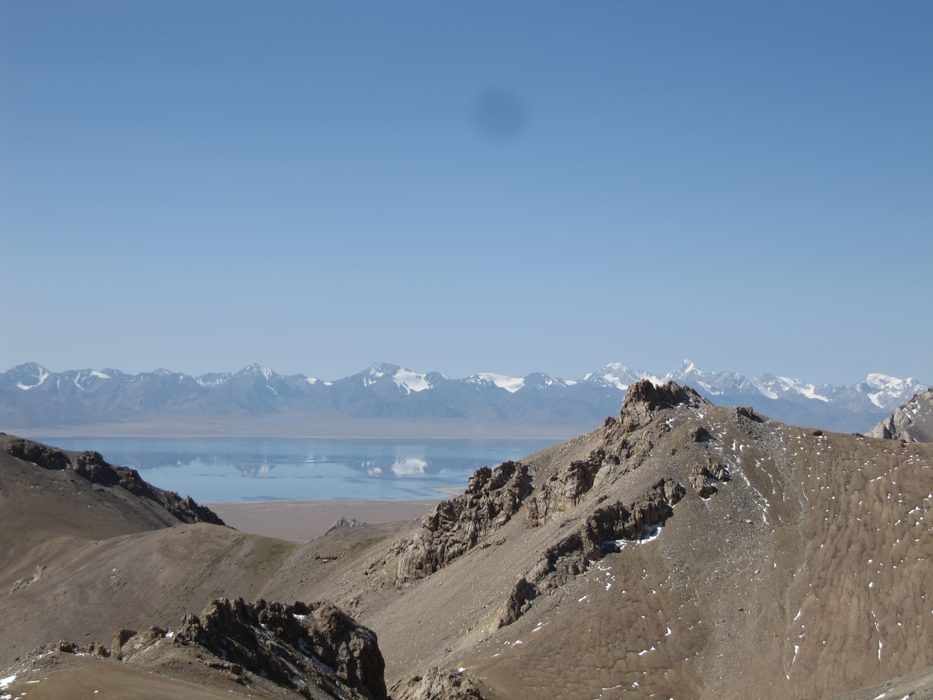
But the icy wind wasn’t to be ignored for long, and it soon chased us down the pass where we led the horses; more for our peace of mind rather than theirs, Bucky following me on a rein like an over-large, obedient puppy. On our descent we passed a herd of yaks, that from a distance were only dark freckles on a hillside, and looked more like mounded movable hearth rugs up close. At that point the sky that had been bright all day, was overcome with an impromptu snow storm. We’d had all sorts of weather earlier in the trek: sun, thunderstorms, rain (even in the desert, a surprise for everyone), wind, hail, often all at once. But this was our first blast of snow. We stopped, throwing on jackets and giant green coats. These were cavernous, shapeless things, made of rubberised canvas, completely unbreathable, and possibly (we thought) relics of the Red Army. But as quickly as the snow started, the wind gusted again and drove it south, where we watched the lake and mountains take their turn under the cloud. As for us, we had some lunch as the sun came out. Afterwards, without a word or a sign, everyone lay down and enjoyed an after-lunch nap while the horses hopped like rabbits around us in their hobbles.
That night was the coldest. We’d ridden for a few more hours, eventually finding a camping spot with a little running water in the shadow of a cliff-studded hill. For a while, we relaxed, chasing the sun across a hillside, while looking out to the range of far off hills in China before decamping into the cook tent. Unlike other camps, the backup crew hadn’t been able to drive to this spot, so everything we had was packed on the horses. And as the temperature dropped, everything we brought was thrown on and zipped up as the stars came out. That far from anything approaching light pollution, the sky was lit up; the stars blushing in a Milky Way smear across the gap from hill to hill. They seemed closer than anywhere else. And as we lay back, huddled on horse blankets and clutching mugs of tea, it was almost as if you’d step out into the black and find yourself surrounded by the pinpricked light.
The next day dawned bright and clear (and cold). As with the day before, we were heading for a high pass, this one at somewhere over 4100m. The climb was again steep and bare; the screes falling like blankets over the hills. It looked barren and unforgiving, but close up, even at that height, tiny flowers clung to the rocks while shale and slate flowered out of the cliffs in bizarre and delicate shapes. In the Alps, this is the altitude of the highest peaks, glaciers and year-round snow. But in Kyrgyzstan our horses dug in their hooves and took it in stride.
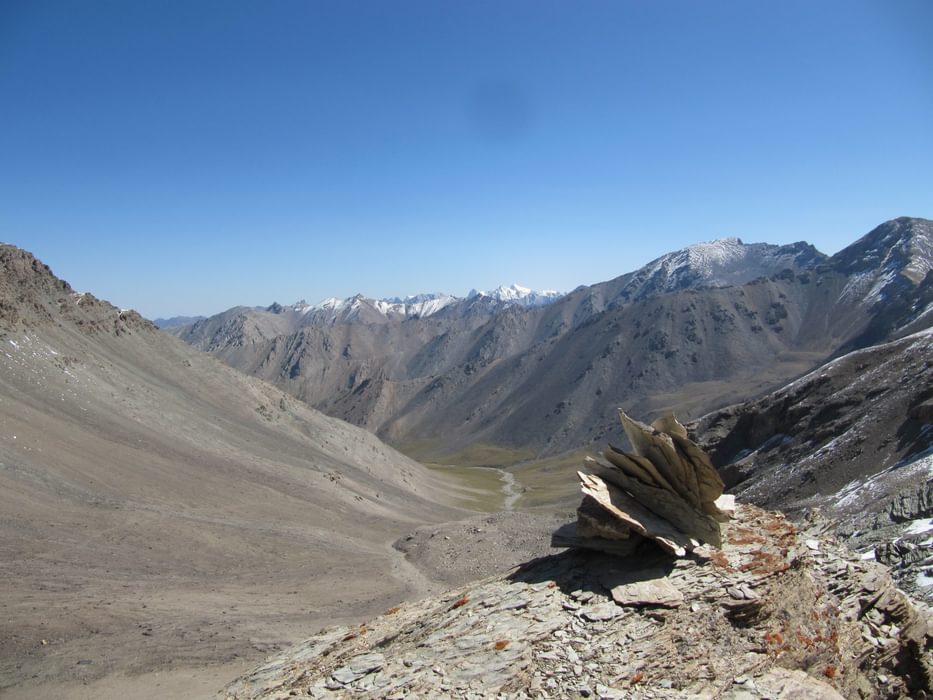
The descent down into a valley was quickly followed by lunch and another nap, which then involved seeing whether we could make a quiet and quick getaway while John, our tour leader, carried on napping. The afternoon ride was idyllic as we followed a bubbling stream which turned into a river as it snaked through narrow cliffs and into wide meadows. The sight of all that green after the stark grey of the high pass was shocking, and just asking for a quick gallop.
Our ride followed the narrow valley and we passed yurts, from which whole families tipped out to wave us past and call out ‘Salaam’.
That evening, our last camp was in a curve of the river on fresh green grass. It was bittersweet. After ten days or so of trekking, we’d fallen happily into the life of riding everyday, finding new sights over every hill. We’d grown to know and trust our horses, and make fast friends of each other. Turning away from that, from the mountains and our new Kyrgyz friends back to a more complicated life felt too soon in coming. We would have been happy to carry on, or at least plan to come back.
Travelling into Kyrgyzstan is not new. Mountaineers and climbers have been making their way into the Tien Shan and Pamirs, to the hights of 7000m mountains like Khan Tengri (Kazakh border), Peak Pobeda (Chinese border) and Peak Lenin (Tajik border) for decades. But lately, the country has been working to increase adventure tourism and make a name for itself for riders, trekkers, cyclists and climbers. Bishkek is a couple of flights away from European cities, and visa restrictions have been dropped for many countries. The people are generous and friendly, the mountains are spectacular. Tian Shan translates as the 'Celestial Mountains', and exploring them is truly an adventurer’s idea of heaven.
Although this was a small supported group trek, it's always useful to remember how remote many places are in the world. Medical assistance can be days away, so carrying a copy of Pocket First Aid and Wilderness Medicine is recommended, together with a full expedition first aid kit.
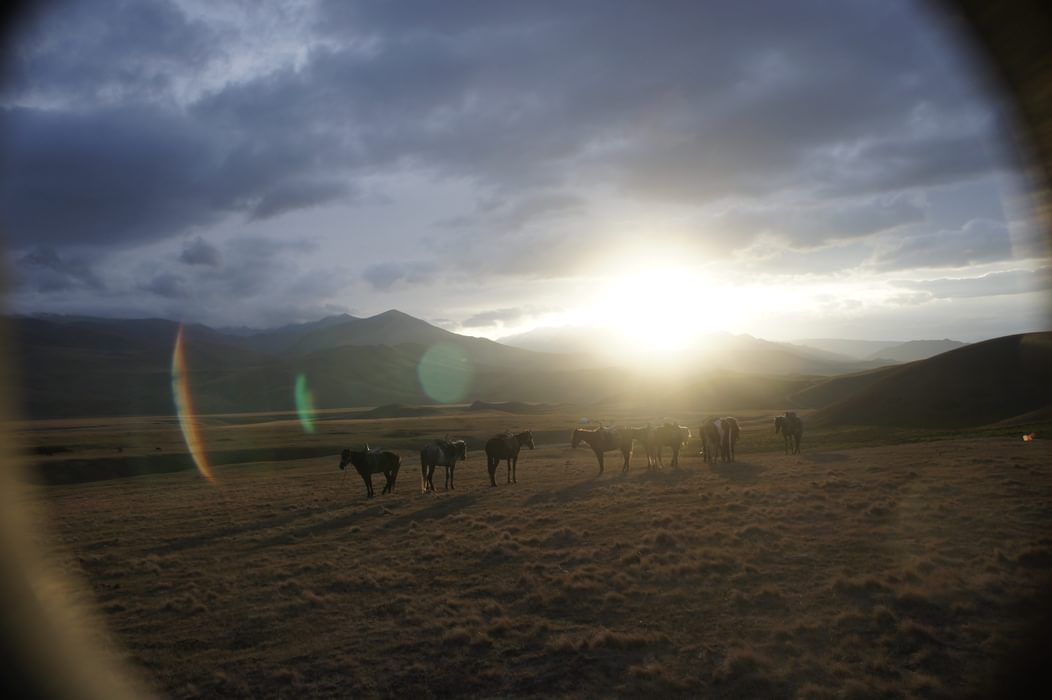
For those interested, Wild Frontiers are an award-winning adventure tour company, offering guided treks and a range of horse riding holidays.
To read more articles like this get our newsletter
Sign up for 20% off your next purchase and to be the first to hear about exclusive competitions, special offers, and news from Cicerone.








